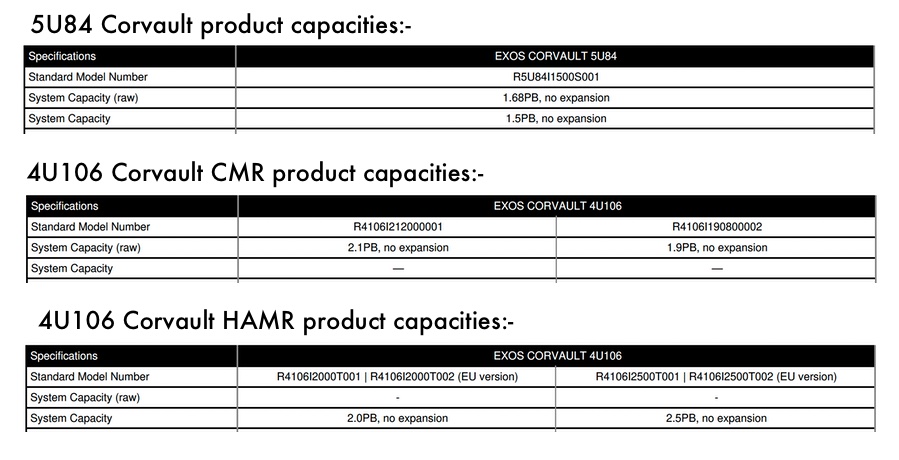As promised Seagate has launched self-healing 2PB and 2.5PB Corvault arrays with HAMR disk drives.
Update: Seagate provided some Exos HAMR drive capacity information; 16 November 2023.
Corvault is an intelligent JBOD-type 4RU chassis with up to 106x 3.5-inch drives, and VelosCT ASIC controllers. It currently runs with Exos 18TB and 20TB conventional magnetic recording (CMR) drives, using ADAPT erasure coding to protect the data and recover from any drive failure. An ADR (Autonomous Drive Regeneration) function is deployed in the chassis to recover from a failed platter surface or head in a ten-platter drive. The drive is taken offline, reset to not use the failed head or platter surface, and then returned to service with reduced capacity. Now Seagate is moving to use HAMR drives and, with a 106-drive count, the 2PB and 2.5PB chassis will be using drives with approximately 21TB and 26TB capacities.
Seagate customer Alexander Ruebensaal, CEO of ABC Systems AG, provided a generic announcement statement: “The data storage requirements and budget constraints for science, research, high-performance computing (HPC), and higher education institutions are substantial. For our customers’ multi-petabyte datasets, we turned to Seagate’s Exos Corvault. Its unique design allowed them to reduce their total storage costs up to 80 percent annually, including technical, operational, service, and maintenance costs compared to previous solutions. These tremendous savings can be reallocated to scientists and researchers.”
There was no statement from any Seagate exec.
HAMR (Heat-Assisted Magnetic Recording) overcomes the problem of room temperature-recorded CMR drives progressively losing magnetic bit stability once the per-platter capacity goes past 2 to 2.5TB. By moving to a different recording material with more bit stability at room temperature as per-platter capacities scale up to 4TB and even 5TB, that problem is solved – but the bits have to be written at higher temperatures. This is achieved by adding a laser to the read-write head and temporarily heating the platter surface just before a bit value is written (magnetic charge put on the drive surface.)
Seagate’s competitors Toshiba and Western Digital are using microwave-assisted magnetic recording (MAMR) technologies to achieve 20+TB capacities, reserving HAMR for use as they progress to 30TB and beyond. Although Seagate says HAMR is its technology gateway to 30, 40 and even 50TB drives, it is here using HAMR technology with lower capacities.
This is somewhat surprising as it already has a 24TB Exos X24 CMR drive. In other words it does not need HAMR tech to produce a ten-platter drive with 2.4TB per platter.
What is the actual capacity of the HAMR drives in the new Exos Corvault products? We can work it out indirectly.
Exos Corvault HAMR drive capacity
An Exos Corvault data sheet describes a 5RU x 84-slot Exos Corvault product with separate 1.68PB raw capacity and 1.5PB system capacity values. Dividing 1.68PB by 84 drives gives us an exact 20TB raw drive capacity.
The lower 1.5PB system capacity number has an amount of each drive’s capacity, around 2.14TB, c10 percent, used for internal system purposes.
The datasheet only provides raw chassis capacity numbers for the 2.1PB and 1.9PB CMR drive Corvault products in their 4RU x 106 drive slot chassis, not system capacity numbers. Allowing for rounding, these use 20TB and 18TB drives respectively.

However, the Exos Corvault products using HAMR drives only have system capacity values given: 2PB and 2.5PB. There are no raw capacity numbers provided by Seagate. Dividing the system capacities by the 106 drive count gets us 18.87TB and 23.59TB per drive, respectively.
Being cunning, if we add back the 2.14TB per drive (c10 percent) reserved for internal system use in the 5U84 Corvault, we can calculate/estimate the raw HAMR drive capacities as 21TB and 26TB respectively. We have asked Seagate to confirm these numbers, and it responded with this: “Various drive capacities are utilized in new CORVAULT system configurations, including Exos X drives with HAMR technology ranging up to 29TB, but overall capacity of the complete system is the focus of this product.”
We understand that the Corvault HAMR drives won’t be available outside Corvault systems. They are separate HAMR drives from the ones Seagate is already talking about as HAMR 30+TB drives, which are expected to arrive early in 2024 with SATA interfaces.
The Corvault 4U106 chassis supports both SATA and SAS, while the 5U84 chassis only supports SAS, and so it cannot be equipped with the Corvault HAMR drive for now.
Both 2PB and 2.5PB capacities in the Exos Corvault HAMR drive configurations can be ordered from storage resellers worldwide in November with product availability at the end of December.








